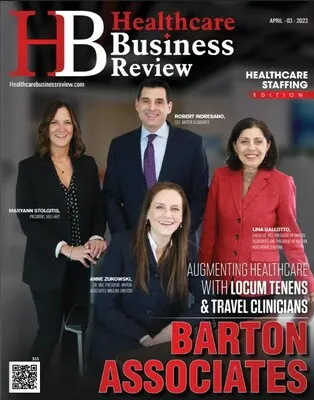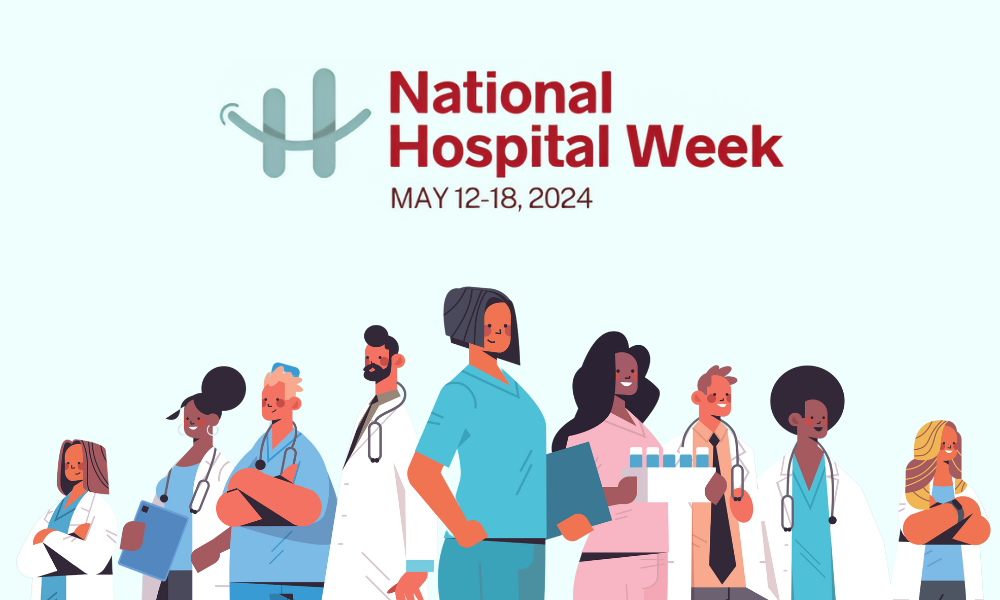In This Issue:
- From Disruption to Revolution: How Tech, Retail are Reshaping Healthcare in 2023
- The Rising Trend of Locum Tenens Providers in Healthcare Facilities
- 3 Key Factors for Choosing a Locum Tenens Staffing Company
- 3 Key Traits and Interview Questions for Locum Tenens Candidates
- AAPPR Presentation Recap: The Changing Landscape of Healthcare Workforce
- All Star Healthcare Solutions Announces New Divisional VP, Human Resources
- Barton Named 2023 Healthcare Staffing Service Company of the Year
- Billing Best Practices for Telehealth Services: 4 Tips for Maximizing Revenue
- Maximize Your Key Accounts: Strategies for Growth and Engagement – NALTO/Butler Street March Webinar on April 18th, 2023
- The Looming Impact of Physician Retirements on Healthcare
- Socially Speaking: Posts of note from D&Y, LT.com, Hayes, CHG Healthcare & more.
- Addressing Clinician Burnout, Staffing, & Capacity: Insights from 17 Health IT Executives
- How Health Systems Harness The Power of Generative AI for Clinician Support
- Decoding The Ethics of AI in Healthcare
From Disruption to Revolution: How Tech and Retail are Reshaping the Future of Healthcare in 2023
(From American Hospital Association, 3/28/2023)
American Hospital Association’s Market Scan shares how major retail, payer, and tech disruptors last year invested billions of dollars in healthcare to transform the field. This report explores the prospects and challenges of key players, such as Amazon, CVS Health, UnitedHealth Group, Walgreens Boots Alliance, Walmart, Apple, and Google, and how their innovative care models, value-based payment models, and adoption of new care approaches are shaping the future of healthcare.
However, these disruptors will face significant challenges this year as they compete for a stake in the $260 billion primary care market, with nontraditional players projected to own up to 30% by 2030.
How Big Tech Firms Are Transforming The Field
Big tech firms like Apple and Google are focusing on leveraging technology in healthcare. Apple aims to empower individuals with its Apple Watch and iPhone while building partnerships with payers, health systems, and researchers.
- Key areas to watch for Apple in 2023 include data transfer to providers, patient willingness to share health data, and potential monetization.
- Google uses AI for personalized data and researches through Google Fit and investments in AI drug discovery startups. Key areas to watch for Google in 2023 include hardware capabilities for monetization, potential involvement in the patient journey, and expansion into medical care and prescription services.
Major Retailers Reshape the Healthcare Landscape
- Amazon focuses on primary care, diagnostics, therapeutics, and care coordination through acquisitions (e.g., One Medical) and services (e.g., RxPass and Amazon Clinic).
- CVS Health is broadening its presence in primary and home care, capitalizing on owning Aetna, and expanding virtual mental health services.
- United Health Group has recently completed its merger with Change Healthcare and is actively expanding its portfolio through strategic investments, partnerships, and acquisitions.
- Walgreens Boots Alliance is prioritizing health care delivery in primary care and home health, investing in providers and home care companies to strengthen its position in the industry.
- Walmart is driving growth in healthcare initiatives through retail health clinic expansion and VBC (Value-Based Care) initiatives, leveraging health technologies, and developing telehealth and VBC strategies. However, challenges remain in meeting care volume and competition with larger rivals, making the performance of these companies closely watched in 2023.
Key areas to watch in 2023:
- Amazon: Scaling primary care, expanding pharmacy base, strengthening hospital relationships, navigating FTC reviews.
- CVS Health: Expanding primary care, facilitating healthcare interactions, and engaging with hospitals and providers.
- United Health Group: Successful integration of acquisitions, Value-Based Care (VBC) model adoption, and continued growth trajectory.
- Walgreens Boots Alliance: Meeting care volume, competition with larger rivals, revenues, and results.
- Walmart: Retail health clinic expansion, leveraging health technologies, consumer relationships, telehealth, and VBC strategies, delivering expected care levels, scaling health centers.
How Will Retail Disruption Impact Healthcare?
To effectively navigate the changing healthcare retail landscape, hospitals should enhance their omnichannel presence, explore partnerships with transformative companies, expand outpatient and virtual services, and collaborate with big tech firms for research and innovation. Proactive adaptation through strategic partnerships, patient trust, and collaboration with big tech firms is essential for hospitals to remain competitive and improve healthcare outcomes.
La Vida Locum
The Rising Trend of Locum Tenens Providers in Healthcare Facilities
(From MPLT Healthcare, 3/31/2023)
MPLT Healthcare explains in a blog post that many healthcare facilities consider including locum tenens providers as part of their staffing strategy due to challenges in finding qualified healthcare staff and rising hiring costs. Locum tenens providers offer several benefits for facilities looking to improve their staffing coverage and patient care.
One key advantage of locum tenens providers is their ability to supplement current staff. When full-time physicians are absent for reasons such as vacation, maternity leave, or illness, locum tenens providers can step in to maintain adequate staffing coverage. They can help during peak times or ease the transition of retiring providers with reduced hours, ensuring that patient care is not compromised due to staff shortages.
Locum tenens staffing also offers temp-to-permanent hiring options for facilities needing permanent physicians but still need to be ready to invest in permanent hires. This arrangement allows facilities to hire locum tenens physicians temporarily before considering them for full-time employment. As a result, both parties benefit, as locum tenens physicians may seek long-term employment while facilities can evaluate their fit before offering a permanent role.
Another significant advantage of locum tenens providers is their impact on patient retention. Staffing fluctuations can directly affect patient retention levels, leading to rescheduled appointments or turning away new patients. By utilizing locum tenens providers, facilities can ensure consistent, quality patient care without disruptions caused by provider vacancies or staffing reductions.
As staffing shortages in the healthcare field worsen, locum tenens providers are becoming an increasingly valuable solution for facilities looking to bridge staffing gaps and maintain high-quality patient care.
3 Key Factors for Choosing a Locum Tenens Staffing Company
(From Health Carousel Locum Tenens, 3/14/2023)
Health Carousel Locum Tenens emphasizes in a blog post how partnering with a locum tenens staffing agency can significantly impact a healthcare organization’s trajectory. By hiring additional staff to fill critical gaps in coverage, you can position your facility for lasting improvements in comprehensive patient care. You can also achieve optimal growth and long-term fiscal success.
However, not all locum tenens staffing agencies are the same, and choosing the right one is essential to achieve your goals. With over 100 US-based companies providing placements to the temporary physician workforce, a wide range of staffing strategies, resource utilization, and procedural differences can make or break the success of your locum tenens experience.
When seeking short-term or long-term partners in patient care, it is critical to evaluate locum tenens staffing agencies based on quality, speed, and flexibility.
Assessing these three factors carefully ensures that you make the best decision to support your current staff and enhance the operational flow of the entire medical system.
Factor 1: Elevating the Standard of Care with High-Quality Providers
Quality of providers is crucial in locum tenens staffing. Assess the agency’s network, specialists, recruiters, and provider-organization interface. Seek feedback from clients to gauge service quality.
Factor 2: Rapid Results: The Role of Speed in Agency Success
Speed and responsiveness are crucial for agencies to succeed. Getting a physician into active care involves complex steps such as licensing, credentialing, privileging, and travel arrangements. Streamlined systems in larger agencies can expedite these processes, accelerating the flow from selection to placement. Timelines are crucial in locum tenens staffing to avoid delays, which can lead to negative impacts like delayed appointments, untreated health conditions, lost revenue, overworked staff, and inefficient work.
Factor 3: How Flexibility Drives Results
Flexibility is vital in locum tenens staffing. Look for agencies offering custom services like contract-to-hire, project-based services, and extended contracts for stability. Discuss contract options with the agency to align with your financial and patient care goals. A broad network of ready-to-go providers ensures continuity of care and makes responding to fluctuations in your care team’s needs more accessible.
Navigating the Search for the Right Agency Fit
Choosing the right locum tenens staffing agency is crucial to avoid adverse consequences with patient care. Working with a responsive agency with high-functioning systems can significantly impact patient care and permanent healthcare staff. The best agencies understand the business model, need areas, and specialty medical practice nuances. Technology-based matching and streamlined staffing systems can offer a broader and highly skilled talent pool, meeting providers’ preferences.
3 Key Traits and Interview Questions for Locum Tenens Candidates
(From Integrity Locums, 4/5/2023)
Integrity Locums observes in a recent blog post that the growing and diversifying healthcare industry creates a need for skilled medical providers. Locum tenens clinicians are a valuable solution for staffing needs, managing patient loads, promoting continuity of care, and saving costs.
Shifting Gears: Assessing Adaptability in Locum Tenens Candidates
Assessing adaptability in locum tenens candidates is critical for a constantly evolving healthcare industry. Locum tenens clinicians need to quickly adapt to new assignments and learn each facility’s policies, procedures, and nuances. Interview questions can assess a candidate’s ability to adapt to different work environments and deliver high-quality care.
Continuity of Care: Assessing Commitment in Locum Tenens Clinicians
Continuity of care is essential for locum tenens clinicians. Candidates should be committed to providing compassionate, patient-centered care throughout their assignments. Interview questions can assess a candidate’s beliefs on delivering exceptional patient care, willingness to take on extra tasks, and staying current with healthcare trends.
Thriving in Uncertainty: Evaluating Flexibility in Locum Tenens Professionals
Flexibility is crucial for locum tenens professionals due to unpredictable staffing changes. Interview questions can assess a candidate’s ability to handle unexpected changes in their work schedule, adapt quickly, and provide examples of times when they had to change priorities quickly.
Evaluating adaptability, dedication, and flexibility during the interview process can help ensure the right hire for locum tenens clinicians. Those with these characteristics can quickly adjust, provide high-quality patient care, and thrive in the ever-changing healthcare landscape.
Locum Leaders
AAPPR Presentation Recap: The Changing Landscape of Healthcare Workforce
(From LocumTenens.com, 3/23/2023)
A recent market research study by LocumTenens.com titled “The Future of Work: Redefining the Role of Physicians in the Gig Economy” revealed that 77% of clinicians reported experiencing burnout at some level. Among them, 40% self-reported moderate burnout, while 17% reported significant or complete burnout. This issue is exacerbated by the retirement of many clinicians in their 40s, which could worsen the existing physician shortage.
Physicians Prioritizing Work-life Balance
The Great Resignation and the gig economy also impact the healthcare industry, with clinicians seeking more flexibility in their work models to prevent burnout and achieve better work-life balance. Physicians are looking for options that allow them more control over their schedules and work arrangements. This shift in preferences will enable administrators to implement creative staffing models that integrate telehealth and advanced practice providers (APPs) into traditional roles, which can help mitigate the worsening provider shortage.
Addressing The Impending Physician Shortage: Projections and Drivers
The projected physician shortage is expected to reach crisis levels, with estimated deficits of 17,800 to 48,000 primary care physicians and 21,000 to 77,100 non-primary care specialists by 2034.
The aging demographic of active physicians in the United States, with more than 2 in 5 physicians being 65 or older within the next decade, is a primary driver of this shortage. As clinicians in their 40s retire, the locum tenens market has seen an increase in providers with less than 10 years of practice experience looking for new and inventive ways to practice medicine while maintaining a work-life balance.
Clinician Workforce Embraces Gig Thinking
The Great Resignation and the gig economy continue to impact healthcare staffing, with clinicians seeking flexibility and opportunities outside traditional roles. Addressing these changing preferences has become necessary for administrators to mitigate the worsening provider shortage. Implementing telehealth and APP solutions can provide new opportunities for hospitals and medical practices to access a wider pool of practitioners who may not have been accessible otherwise. Successful systems are willing to pilot and build upon what works, creating flexible staffing solutions that improve care access and decrease clinician availability stress.
Finding A Way Forward
The future of the healthcare workforce requires innovative and flexible staffing models to address the challenges of burnout, physician shortage, and changing preferences of clinicians. By integrating telehealth and APPs into traditional roles, administrators can create sustainable solutions that improve access to care, decrease clinician burnout, and ensure better patient and provider outcomes. The evolving landscape of healthcare demands strategic thinking and proactive measures to adapt to the changing needs of clinicians and patients alike.
Lisa Sharoni, SHRM-CP, Divisional Vice President, Human Resources, All Star Healthcare Solutions
All Star Healthcare Solutions Announces New Divisional VP, Human Resources
(From StreetInsider.com, 3/23/2023)
All Star Healthcare Solutions recently welcomed Lisa Sharoni, SHRM-CP, as their new Divisional Vice President of Human Resources. With a healthcare administration and human resources background, Sharoni brings a wealth of experience and innovative thinking to the company. As a member of All Star’s senior leadership team, Sharoni will be responsible for shaping essential HR functions and developing strategies that align with the company’s people-centric and performance-driven culture.
Keith Shattuck, CEO of All Star, emphasized the importance of delivering their signature “Red Carpet” Service not only to healthcare facilities, providers, and partners but also to their employees and noted that Sharoni would play a crucial role in those efforts.
Lee Kennedy, COO, added that Sharoni would bring a fresh perspective to create well-rounded initiatives that benefit the company’s operations and promote employee work/life balance options.
Ken Bernstein, President of All Star, expressed excitement about Sharoni joining their team and providing superior guidance as they continue to hire and enhance their caring and supportive culture.
Barton Associates Awarded Healthcare Business Review’s 2023 Healthcare Staffing Service Company of the Year
(From PR Newswire, 3/31/2023)
Barton Associates, the fourth largest locum tenens staffing and recruiting agency in the U.S., has been awarded the prestigious Top Healthcare Staffing Service Company of 2023 by Healthcare Business Review.
The company’s outstanding achievements were showcased on the cover of the March 2023 edition of the magazine, featuring Robert Indresano, CEO of Barton Associates, Lina Gallotto, EVP of Barton Associates and President of Barton Healthcare Staffing, MaryAnn Stolgitis, President of Wellhart, and Anne Zukowski, SVP of Barton Associates’ Inbound Division.

The article highlights the success, growth, diversity, and unique training approach of The Barton Companies. The collective mission of the three businesses is to tackle the healthcare crisis in the United States by providing healthcare facilities nationwide with access to highly skilled medical providers and clinicians, enabling clients to fulfill their crucial mission of providing healthcare to those in need, especially in underserved communities.
Lina Gallotto, Executive Vice President of Barton Associates and President of Barton Healthcare Staffing, likens their locum tenens providers to “doctors without borders” as they strive to serve medically underserved communities within the United States, similar to the selfless service provided by doctors in underserved countries.
The Barton Companies is experiencing significant growth and have ambitious plans, including opening a new office in Las Vegas in June 2023 and recruiting hundreds of new employees across their eight other offices.
Hire Power
Billing Best Practices for Telehealth Services: 4 Tips for Maximizing Revenue
(From LocumTenens.com, 3/16/2023)
A recent blog post on LocumTenens.com highlights the rapid adoption of telehealth healthcare providers to embrace new technologies and seize new opportunities. However, specific barriers to adoption, such as uncertainties surrounding reimbursements, must be promptly addressed. Moreover, healthcare organizations must be open to investing in telehealth services to leverage this evolving field’s benefits fully.
A report by the American Medical Association revealed that 62% of patients experience increased satisfaction with telehealth. A better understanding of the concerns and opportunities around telehealth will help ensure the long-term sustainability of telehealth programs.
To help hospitals struggling with this issue, LT.com offers four billing tips to get the most from telehealth services:
1. Understand the difference between originating and distant sites
It’s crucial to differentiate between originating and distant sites in telehealth, as reimbursement rates vary based on location. CMS reimburses higher for services at an originating site, like a physician’s office in the US or its territories. A distant site refers to services received outside a medical facility, including a telehealth appointment from home. Understanding these nuances is vital for accurate billing and reimbursement in telehealth.
2. Ask insurance payors about additional requirements for telehealth enrollment
Health insurance payors often have additional requirements related to telehealth information. Providers must meet all telehealth enrollment requirements, submitting applications, and billing guidelines. Providers must also familiarize themselves with these requirements to ensure proper compliance.
3. Push for higher levels of reimbursement from CMS and payors through lobbying efforts
Healthcare organizations must advocate for proper reimbursement practices to highlight the value of telehealth. Barriers remain in expanding telehealth adoption across service lines and locations. Hospitals and medical practices often cite poor reimbursements as hindrances to investing in and developing telehealth services. Telehealth is crucial in improving access to healthcare for growing populations.
4. Work with an expert to maximize your billing processes to ensure there are no gaps
Providers should collaborate with experts to optimize billing processes and minimize gaps. Reimbursements can be complex for in-person or virtual care, and expert assistance can optimize processes for better financial outcomes. Understanding billing practices and maximizing reimbursements is crucial for the sustainability of telehealth programs. Healthcare organizations can optimize telehealth services and improve patient care by following these billing tips.
Maximize Your Key Accounts: Strategies for Growth and Engagement – NALTO/Butler Street March Webinar on April 18th, 2023
(From NALTO)
Join NALTO and Butler Street for their upcoming webinar, “Strategic Account Management: Reducing Risk and Increasing Engagement,” at 2 pm ET on April 18, 2023.
In this client-focused event, they will share tips and best practices to increase engagement with your key accounts. The webinar will help you understand how to approach your accounts strategically, gain insights on recognizing risk, and discover why client retention is the new expansion.
This is a must-attend event for anyone looking to advance relationships with their key accounts and succeed in today’s challenging economic environment. Sign up here to secure your spot and gain valuable knowledge and strategies to help you succeed.
Don’t miss the opportunity to elevate your account management to new heights!
Making the Rounds
The Looming Impact of Physician Retirements on Healthcare
(From Revcycle Intelligence, 3/22/2023)
According to a survey conducted by Jackson Physician Search, healthcare organizations must prepare for a potential wave of physician retirements. The study found that 62% of physicians have kept their retirement plans unchanged despite the current economic headwinds.
However, if they did postpone their retirement, the majority say they would delay it by one to four years. The COVID-19 pandemic remains a factor in physician retirement, with 24% of physicians stating they plan to retire early due to the pandemic.
The healthcare sector must attract and retain physicians in different ways than those employed in the past by offering part-time work, flexible schedules, and reducing on-call requirements. Addressing physician burnout is a critical pillar in physician recruitment and retention strategies.
Most physicians prefer notice of three months or less for transition plans, while healthcare administrators prefer one to three years. The study found that 69% of administrators still need formal, written succession plans.
The findings indicate that most physicians retire as soon as they can afford to, which means healthcare organizations will likely lose essential workforce members shortly. According to the Association of American Medical Colleges, nearly half of practicing physicians were over 55 in 2021.
The survey shows healthcare organizations must adapt physician recruitment and retention strategies for retirement planning. Offering part-time work and flexible schedules could delay retirement plans, with addressing physician burnout being crucial. The study reveals that burnout/overwork (24%), lifestyle (23%), financial stability (22%), and age (12%) are leading factors driving physicians to consider retirement.
Tony Stajduhar, president of Jackson Physician Search, said that greater emphasis on initiating the retirement discussion and accommodating physicians’ desire to transition from full-time work to retirement is vital to keeping them in the workforce longer. He added that recruiting a culturally aligned physician in today’s competitive market often takes 6-12+ months and costs $250,000 or more, including sourcing, relocation, and a sign-on bonus.
Socially Speaking
From LinkedIn
From Twitter
Second Opinion
Addressing Clinician Burnout, Staffing, & Capacity: Insights from 17 Health IT Executives
(From HIT Consultant, 3/23/2023)
Accenture has released a report on the growing clinician shortage, citing that healthcare workers are increasingly leaving the industry, which is leading to those who remain overburdened. Health IT solutions are potentially addressing clinician burnout and staffing shortages.
In a HIT Consultant news post, seventeen healthcare IT executives shared their insights on how health IT solutions could help address burnout and shortages. These insights include using technology to automate and augment repetitive tasks, creating influential master patient indices to manage data more accurately, employing tech-enabled virtual care teams to offload routine tasks, and using AI-powered automation to reduce the length of stay.
According to the report, the clinician shortage has reached a new level of urgency as we face rising demand and healthcare costs. Healthcare workers are increasingly burned out and leaving the industry altogether in droves. Those who remain to do the work are overburdened.
Read the seventeen healthcare IT executives’ insights here on how health IT solutions could help address clinician burnout, staffing shortages, and capacity.
How Health Systems Harness The Power of Generative AI for Clinician Support
(From Becker’s Hospital Review, 3/22/2023)
Hospitals and health systems are increasingly turning to healthcare startups utilizing AI-based technology, like ChatGPT, to tackle provider burnout and enhance automation, according to Becker’s Hospital Review.
For instance, the University of Kansas Health System has partnered with Abridge, an AI-powered medical documentation company, to implement generative AI technology in over 140 locations to summarize medical conversations.
Similarly, the University of Pittsburgh Medical Center (UPMC) has adopted Abridge’s AI-based technology to digitize virtual primary-care exchanges, alleviating physicians’ documentation burden. Many hospital technology leaders prioritize reducing the documentation workload for clinicians. Generative AI technology, like the one employed by Abridge, is considered “lower stakes” as it has a minimal direct impact on patients.
While ChatGPT’s suitability for clinical settings is still pending due to its reliance on existing medical and popular literature for clinical question responses, UPMC plans to implement Abridge’s platform on a larger scale after its integration into electronic health record systems. Analysts like Jeff Cribbs from Gartner consider generative AI assisting with documentation and synthetic data as “lower stakes” regarding patient impact.
Healthcare startups offering AI-based technology, akin to ChatGPT, have the potential to make significant strides in the industry as hospitals and health systems seek solutions to address provider burnout and enhance automation. As exemplified by Abridge, generative AI technology is being actively deployed in hospitals and health systems to reduce physicians’ documentation burden in widespread implementations.
Decoding The Ethics of AI in Healthcare
(From Becker’s Hospital Review, 3/16/2023)
Although artificial intelligence (AI) has become prevalent in healthcare, digital leaders told Becker’s Hospital Review that they believe it has limitations. Dr. Jeffrey Ferranti, who holds the positions of senior vice president and chief digital officer at Duke Health, highlights the limitations of AI in replacing the essential human elements of healthcare. These elements include providing empathy, ethical frameworks, and respect for personal values.
While AI can assist doctors and provide accurate diagnoses, critical clinical decisions should always be made with human oversight to ensure the human touch and compassionate care that patients require. Although AI can assist doctors and provide accurate diagnoses, critical clinical decisions should always be made with human oversight.
“Next-generation AI, such as large language models, can free up more time for clinicians to deliver more ‘humanistic and empathetic care.’ According to Christopher Longhurst, MD, a chief medical officer and chief digital officer of UC San Diego Health, AI will never replace this. Instead, AI should be viewed as ‘augmented intelligence,’ helping providers interpret large amounts of data to make wise human decisions.”
AI can also be used to redirect patient portal messages away from physicians to a more appropriate care team member and provide personalized, anticipatory advice to expectant mothers; it should not replace the healing touch and empathy provided by compassionate clinicians, said Albert Chan, MD, a chief digital health officer of Sacramento-based Sutter Health.
Generative AI can replace some repetitive tasks in healthcare. Still, it cannot replace roles that depend on human empathy and critical decision-making in ambiguous situations, said Ashish Atreja, MD, CIO, and chief digital health officer of UC Davis Health. Although AI chatbots like ChatGPT have started giving medical advice, most Americans say they’re uncomfortable using AI in their medical care.









